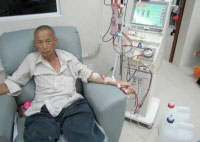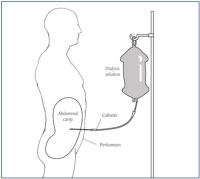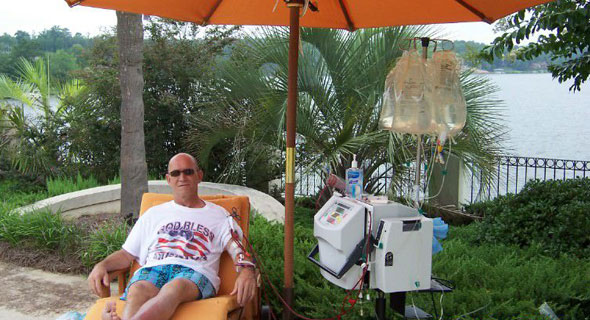Changes to Medicare Rules Can Improve Dialysis Care
Article by Andrew King, MD
Head Nephrologist, Scripps Clinic, San Diego, CA
Medical Director of Home Dialysis Therapies of San Diego
Home dialysis is underused in the United States. A Medicare rule-change now requires clinics to tell people on dialysis about all of their treatment options. This includes education about the benefits of home dialysis—and where to find it. The rule went into effect as of Oct. 14, 2008.

Medicare updated its rules for dialysis clinics (Conditions for Coverage of Dialysis Facilities) for three reasons:
- Patient rights
- Patient safety
- Patient's participation in care
So, what do the revised rights and regulations mean for you?
Revised Rules Benefit You
Certified Medicare dialysis programs now must:
- Meet your emotional, physical, and communication needs. These include what language you speak, how well you can see and hear, and any concerns about your privacy.
- Offer you a chance to read your chart and go to your care plan meetings.
- Tell you about all of your treatment options—in-center, home, and transplant.
- Tell you whether or not your clinic reuses dialyzers.
- Tell you what is and is not paid for by Medicare.
- Ensure that you know how to file a complaint if you need to, so your voice can be heard.
All of these points help you by making the clinic more responsive to your needs.
Your Roles and Responsibilities
You also have a role to play in making sure you receive the best care possible:
- Go to your care planning meetings so you have input and receive good care.
- Know that you have the right not to attend—and even the right to refuse dialysis if that's your wish.
- Communicate your grievances by filing a confidential report with the clinic.
Taking part in your own care planning and giving feedback through the clinics' surveys is vital. This helps ensure that you're comfortable with your treatment plans, and lets your clinic see how it's doing—and make changes if it needs to. Survey feedback can lead to more staff training, better privacy measures, adding TVs, and more.
Decide on a Treatment Option that Meets Your Needs and Lifestyle
One of your first tasks may be to make sense of your treatment options. Here are brief descriptions of your choices:
- In-center hemodialysis
-

Standard in-center hemodialysis (HD) is done three times per week for 3-4 hours at a time. Some find this suits their work styles; most centers will let you do work during treatments. But, the "dialysis hangover" caused by removing fluid only three times a week may leave you feeling washed out and sick to your stomach after treatments. Plus, the in-center HD meal plan and fluid limits make it harder to do lunch or dinner business meetings.
In-center nocturnal HD treatments are also done three times per week. Instead of 3-4 hour treatments, though, you can do 8-hour treatments at night while you sleep at the clinic. This option—the newest one of all— gives you the benefit of much better treatment and more normal diet and fluids if you don't have a partner for home HD. (Most home HD programs require a partner; some will allow people to dialyze alone.)
- Peritoneal dialysis
-

Peritoneal dialysis (PD) is a flexible option for home dialysis. It uses the lining of the inside of the abdomen (the peritoneum) as a filter to clean your blood without using needles. PD is easy to learn—in about a week—and easy to do, as long as you follow the steps you are taught to avoid infection.
With PD, you'll have freedom to travel without having to arrange treatments at a center months in advance, and the supply company will ship you what you need. Most people who do PD have a more normal diet with fewer fluid limits.
- Home hemodialysis
-

When you learn to do home hemodialysis (HHD), you can choose your own schedule and keep your normal hours, rather than fitting in-center HD into your day. You can get your treatments in the privacy of your own home. Most importantly, you can get much more dialysis, which improves your chance of feeling well, staying out of the hospital, and living longer.
These days, most people who do HHD either choose to do short treatments (2.5-3.5 hours) 5-7 days per week or nocturnal treatments 3-6 nights per week while they sleep. Either option offers a more normal diet, fewer (or no) fluid limits, fewer medications to take (blood pressue pills and phosphate binders may be a thing of the past), and survival that rivals transplant.
Can you afford home dialysis? Rest assured that Medicare and most major private insurances pay for home treatment, just as they would pay for in-center care. In addition, you become eligible for Medicare from day 1 when you train for home treatment. (There is a 90-day wait for Medicare when you do in-center HD, and those 90 days can be very costly for you.) Check with your clinic and insurer to learn exactly what will be covered.
Other Advantages of Home Dialysis
Home dialysis helps you to lead a more normal life in a number of ways:
- Allows you to work with your care partner to create a treatment schedule that fits your lifestyle.
- Offers independence and freedom to get back to living—to work, spend more time with family and friends, travel, etc.
- Reduces the risk of infections that are are passed from patient to patient in a public dialysis clinic.
- Helps you avoid "dialysis hangover" by removing water from your blood more slowly and gently.
Kidney failure is not an end, it's a beginning. Your life on dialysis can and should be about more than dialysis. Know your rights and responsibilities—and your options—and you can create the life you want.
For more information, please visit Home Dialysis Therapies of San Diego's website at www.homedialysistherapies.com or call 858-549-3400.

